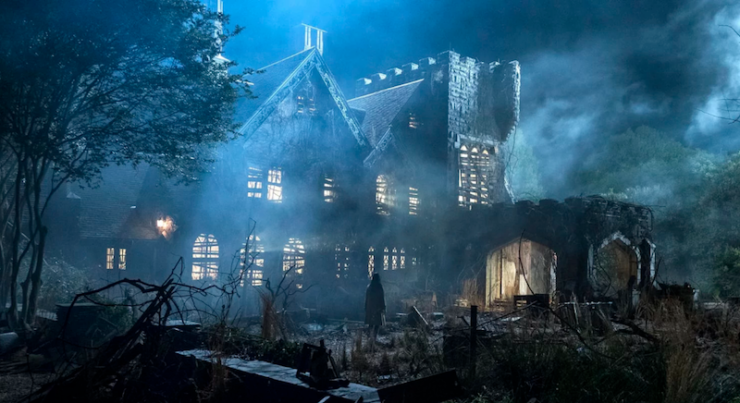Mike Flanagan’s adaptation of The Haunting of Hill House is easily one of the best things I’ve seen on Netflix. It’s consistently scary and moving, creepy and heartfelt, and creates one of the best, most multi-dimensional views of a family I’ve seen since Six Feet Under.
And as a work of horror, Hill House works because it’s an adaptation. It takes Shirley Jackson’s novel as more of a sketch than a blueprint, and it frees itself to riff on the horror genre as a whole.
The key to Shirley Jackson’s book is that, about halfway through, you start to realize that Eleanor isn’t remotely trustworthy. Neither is Theo—she’s only really come to Hill House to inflict some extended silent treatment on her lover, probably a girlfriend whom she won’t name to the group. Dr. Montague’s kind of a quack hobbyist, using his wife’s money to fund a highly unscientific study. Luke is at least pretty upfront about being an oily thief. And then Mrs. Montague and her probably-boyfriend blow in, shred what’s left of Dr. Montague’s credibility, and snicker about the whole project with the disdainful Mrs. Dudley. Read a certain way, the book is an arch satire about relationships, gender roles, and 1950s-era conformity, but then Eleanor and her intense neediness crash through the whole thing, turning it into a terribly sad story of untreated mental disturbance.
I mean, unless the ghosts are real.
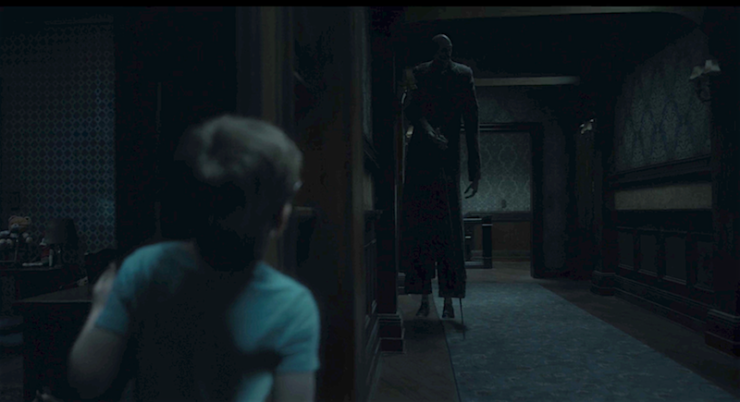
Where Mike Flanagan’s adaptation of The Haunting of Hill House is brilliant is that it takes both readings of the book seriously, and draws on both of them in equal measure.
By taking Hill House’s characters and remixing, riffing, and taking enormous liberties with the source material, Flanagan’s adaptation comes the closest to honoring the book’s spirit.
In the book, the Crains are the long-dead alpha family of Hill House, the Dudleys are the House’s caretakers, and the paranormal investigation team are hubristic interlopers. In the show, the Crain family are house flippers who move into Hill House in the summer of 1992, with the intent of fixing it up, selling it, and using the profit to build “the forever home” where they’ll finally settle in time for the kids to start school. The Crain family consists of parents Hugh and Liv—the builder and designer respectively, adding up to a solid architectural team—and their five children: Steven, Shirley, Theodora, and twins Luke and Nell. The Dudleys are still the House’s caretakers, and they live in their own little house on the edge of the property. The Dudleys know things are wrong with the House, but they’re not sure it’s their place to say so.
Elements of the book’s Eleanor Vance are spread between Liv and Nell. The show’s Luke is a modernized, much more empathetic version of the book’s. Shirley seems like a riff on Book Eleanor’s sister Janet… except Liv Crain’s sister is also named Janet. Dr. Montague is here in a completely different form than his book counterpart, as is Mrs. Montague’s boytoy Arthur. Theodora is still Theodora (because somebody has to be the foundation wall) but she’s able to be much more herself here than she could in the book. And then there’s the eldest, Steven, who doesn’t come from the book at all—his closest parallel is Bill Denbrough, the eldest member of the Loser’s Club in Stephen King’s It.
It is all over Hill House. Like Stephen King’s classic novel and its various adaptations, Hill House coils between past and present tighter and tighter until it shows us that there is no such thing as past, ever. When it comes to horror, trauma, and family, everything is always Now. The show also references The Shining, with Hill House often doing its very best impression of the Overlook Hotel; on The Babadook’s focus on the line between motherly love and abuse; on J-horror in general, in its tendency to use women with long, dark hair as instruments of terror; and, in my own favorite riff, Evil Dead II, when Hugh Crain spends part of an episode in a blood-splattered blue button-down that is the spitting image of Ash’s classic look.
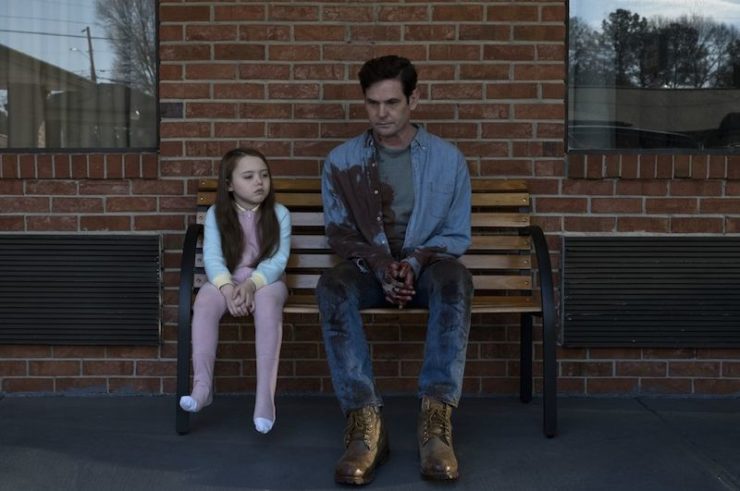
Each character is explored with astonishing richness and depth. Steven’s career as a writer and troubled marriage are treated with gravity, and never once descend into the cliche of alcoholic asshole writer. (THANK YOU.) Shirley’s career as a mortician honors the work of those who prepare the dead, and also acknowledges that on a certain level all the funerary arts are illusions meant to shield the rest of us from the stone cold reality of death. Theo’s work as a pediatric therapist shows that she has empathy for the innocent, but is never used to soften her prickliness—the show likes her prickly. Luke’s addiction is treated as a disease. Nell’s mental disturbance is treated as a disease. Both things must be dealt with with compassion and love, not mocked or punished or swept under the rug. Finally the Crain parents are so complex, loving, and sad, with their own inner lives that have nothing to do with their children.
Even the Dudleys are great!
I don’t even know who my favorite is. (Just kidding, it’s Theo. Of course it’s Theo.)
The show also does that fantastic thing where it never over-explains the horror. The show itself seems to accept the ghosts as reality, but that doesn’t mean all the characters have to, and that doesn’t mean it has to give us long-winded unnecessary backstory. Just as Shirley Jackson never really explains why Hill House exists under conditions of absolute reality, Flanagan doesn’t give us any genealogies or taxonomies of the various hauntings. We get a few hints about why certain ghosts might be sticking around, and why certain family members might be more vulnerable than others, but Flanagan and the writers aren’t holding our hands here.
Wait, whose hand am I holding?
Ugh, not again.
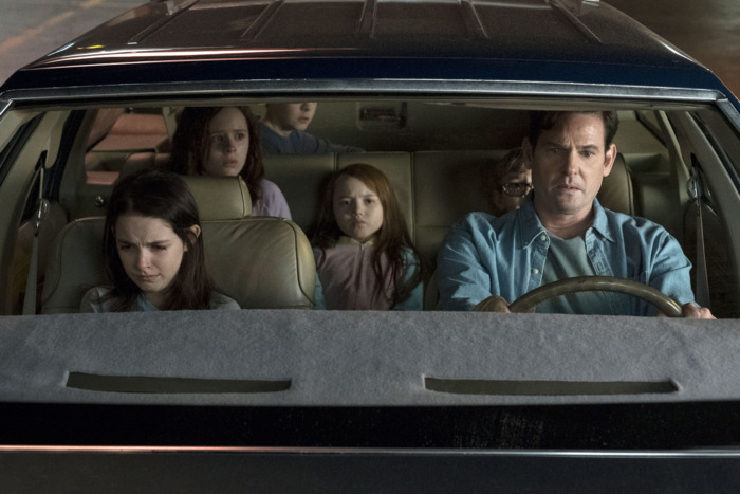
Speaking of that, the show touches on iconic moments from the book: the Cup of Stars, the writing on the walls, “Journeys end in lovers meeting,” the staircase in the library, the book of secrets, the spectral picnic, the cold spot, the stained glass windows, the nursery, nobody being able to trust Luke, two of the female characters huddling in bed at night while SOMETHING pounds on the walls… all of those touchstones are here, just refracted in new ways that tell a different kind of story. The famous opening and final paragraphs of the book are paraphrased in ways that will either infuriate or delight you, depending on how faithful an adaptation you’re looking for. Personally I was delighted in the first instance, and then had to seriously ponder the second before deciding on somewhat conflicted acceptance.
Buy the Book
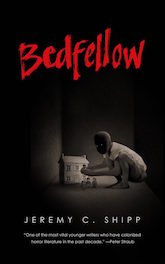

Bedfellow
Meanwhile, “The Bent-neck Lady” has one of the most horrifying sequences I have ever seen in film, TV, anything. No spoilers, but good god, show. The floating apparition we here in the office have dubbed ‘Bowler Man’ is blood-curdling. “Screaming Meemies” mines similar emotional veins to The Babadook and Hereditary, but turns up rich jewels of its own. “Witness Marks” features one of the best slow-burn horror reveals I’ve seen on a shows in ages. And the show makes the best use of an autopsy room since Buffy.
The acting throughout is extraordinary. I know it probably sounds like I’m being too effusive, but the casting is perfect—the kids all look like their grownup selves, and they all look like they’re the spawn of Henry Thomas and Carla Gugino. The shifts between Henry Thomas and Timothy Hutton as Hugh Crain are simply perfect, and we can trace the exact damage he’s done to Steven—Paxton Singleton does an incredible job as the eldest son who’s trying to be just like his dad, and we can see how all of that idolization curdles into Michiel Huisman’s performance as adult Steven. Kate Siegel as Theo edges right up toward Catherine Zeta-Jones’ performance in the 1999 attempt at Hill House, but gives her more gravitas. Violet McGraw and Julian Hilliard have so much chemistry as young Nell and Luke that I thought they were really siblings until I googled them, and Oliver Jackson-Cohen and Victoria Pedretti each give sensitive portrayals of their adult counterparts’ respective illnesses, making them only part of their larger characters rather than defining traits.
But oh gosh Timothy Hutton.
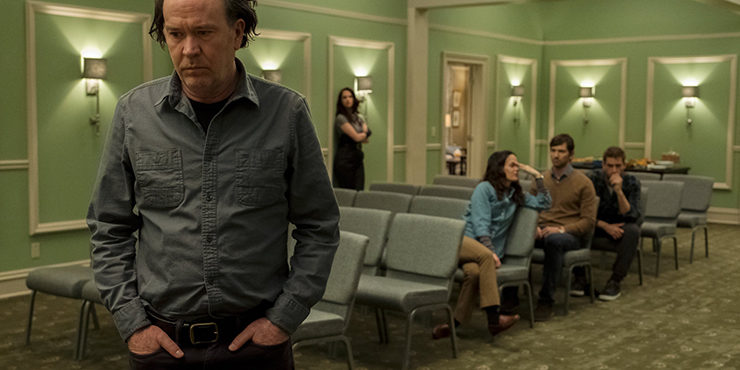
See at the center, the heart, of this show is a portrait of a very unique partnership between Hugh and Olivia Crain. This partnership is sorely tested by the summer they spend at Hill House—to put it as mildly as possible—and Timothy Hutton plays the older Hugh Crain as a defeated man who is shrouded in layer after layer of defeat, giant, life-shattering defeat and tiny every day indignity. Yet he still believes in his partnership, and what was created from it, and watching him decide when to fight for it is fascinating. You can see the tiniest sparks of determination light up in him and fight their way through all those layers. Any scene with him and one of his adult children is among the best scenes on TV this year.
There were a few points across the ten episodes where I wished the show focused on horror rather than family drama, and a couple of monologues between the Crain siblings that went on a few minutes past their peaks. But those are tiny ripples on a deep and wonderful sea. Also! I have seen a few critics who thought the show kind of came apart in the end, because it chose to make some sizable changes from the book at that point and give the Crains what seems like a happy ending. I’ve been mulling it for two days now, and I think I agree with the way Flanagan chose to ease viewers back out of the this part of the Crain saga, while still leaving room for another season. Plus, just between you and me? I don’t think it’s a happy ending at all, and I think if there is another season, we’ll all get to explore that.
For the most part Hill House, like all the best horror, rooted its frights in the relationships between people. The show made us care for the Crain family, and it made us root for them to escape the horrors of Hill House and the weight of their own lives. In stand-out episodes like “The Bent-neck Lady” and “The Twin Thing” it reminded us that ordinary life itself can be a nightmare, but by the final episode, it also takes a potentially disastrous moral stance, and affirms that the love between brothers and sisters, and parents and children, can give us a lifeline. That love can even create an escape plan for the nightmare of life. After three days of pondering, I’m going to say that the show’s most radical departures from Shirley Jackson’s novel are what help it stick the landing as a classic work of television.
Leah Schnelbach always insists on her Cup of Stars. Journeys end in Twitter meetings?










